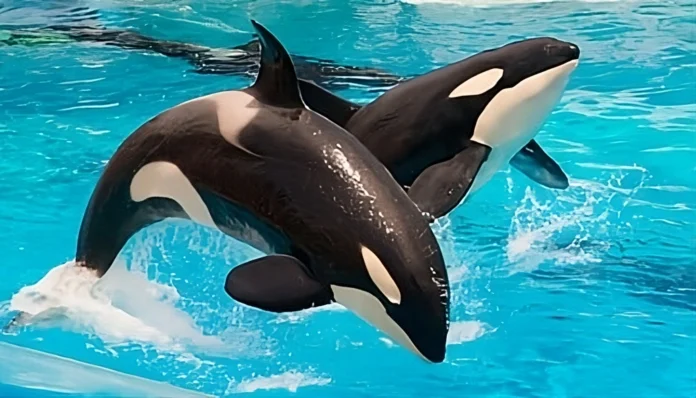The ocean is full of mysteries, and few creatures captivate both scientists and everyday folks quite like the Killer Whale. These incredible marine mammals are not just smart and social; they’re also incredibly powerful, ruling the waves with their strength and teamwork. Their ability to communicate and their deep emotions make them truly remarkable.
Killer whales certainly leave a lasting impression. They cut through the icy Arctic waters and gracefully navigate the warm coastlines. But who are they beneath the surface? Let’s explore the fascinating world of the Orcinus orca, where survival, family bonds, and intelligence come together in a stunning display of nature.
Table of Contents
Scientific Classification
- Common Name: Killer Whale
- Other Name: Orca
- Scientific Name: Orcinus orca
- Family: Delphinidae (Oceanic dolphins)
- Order: Cetacea
- Class: Mammalia
- Phylum: Chordata
- Kingdom: Animalia
Description
Killer whales, often called orcas, are some of the most iconic creatures in the ocean. With their striking black-and-white coloring and powerful build, they really stand out. Interestingly, despite their name, killer whales aren’t actually whales at all; they’re the largest members of the dolphin family (Delphinidae).
These magnificent adults can grow anywhere from 23 to 32 feet (7 to 10 meters) long and can weigh as much as 6 tons. Males are significantly larger than females, sporting a tall dorsal fin that can reach heights of up to 6 feet (1.8 meters). In contrast, females have smaller, more curved fins and a sleeker look.
Their bodies are shaped like torpedoes, designed for speed and efficiency. Killer whales can reach impressive speeds of up to 34.5 mph (56 km/h) in short bursts, making them one of the fastest marine mammals in the ocean.
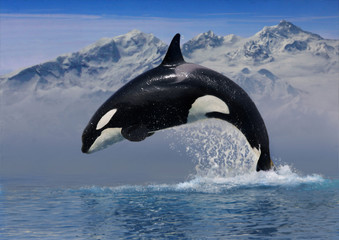
Distribution
Killer whales, also known as orcas, have one of the most extensive ranges of any mammal on the planet, coming in just behind humans. These incredible apex predators can be found in every ocean, from the frigid polar regions to the balmy tropical waters. They tend to thrive in cold, nutrient-rich environments.
Some notable populations are located in:
– North Pacific (Alaska, British Columbia, Washington)
– Antarctic waters
– North Atlantic (Norway, Iceland)
– Southern Ocean (South Georgia, Kerguelen Islands)
You can catch a glimpse of them along the coasts of New Zealand, South Africa, Australia, Japan, and Patagonia.
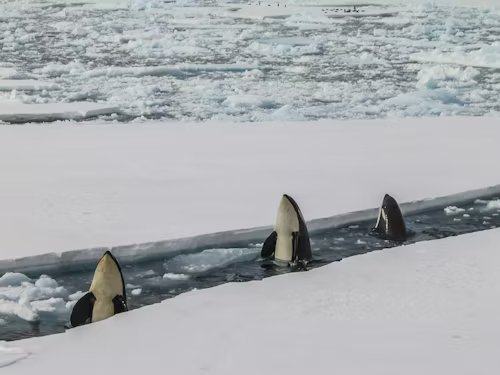
Habitat
Killer whales are flexible with where they live. You can find them in both open oceans and coastal waters. Some populations are known to prefer:
- Deep pelagic zones for hunting large prey
- Sheltered bays and fjord systems during calving and resting
- Ice edges in the polar regions for hunting seals and penguins
Diet
When it comes to killer whales, don’t let their name fool you—they’re not a danger to humans in the wild. However, these magnificent creatures are indeed formidable carnivores, and their diet reflects the diverse environments they inhabit.
As apex predators, killer whales are relentless hunters. What they eat can vary widely depending on their location and the specific type of orca:
- Fish-eating pods: These orcas feast on salmon, herring, cod, and mackerel.
- Mammal-eating (transient) pods: They target seals, sea lions, dolphins, porpoises, and even large whales.
- Offshore orcas: Their menu includes sharks and rays, with a particular fondness for the livers of great white sharks.
Killer whales are known for their clever hunting strategies. They can wash seals off ice floes and execute coordinated attacks on massive baleen whales. Their intelligence and teamwork are reminiscent of wolves, which is why they’ve earned the nickname “wolves of the sea.”
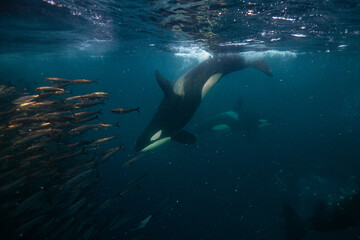
Behavior
Orcas are not lone wolves; they thrive in intricate social structures known as pods. These pods typically consist of anywhere from 5 to 30 members, but occasionally, you might spot a superpod with over 100 orcas swimming together. At the helm of each pod is usually a matriarch, often the oldest female, who leads the group.
These pods collaborate during hunts and collectively look after their young. Each pod has its own unique vocal dialect, which they use to communicate with one another. Their behavior is a fascinating blend of discipline, playfulness, and deep emotional connections.
Here are some notable behaviors you might observe:
- Spyhopping: This is when they raise their heads vertically above the water to get a better look at their surroundings.
- Breaching: They leap out of the water, often for fun or to send a message.
- Tail slapping: This can be a way to signal to others or to stun their prey.
- Mourning: They have been seen holding onto deceased calves or pod mates, indicating strong emotional ties.
When it comes to communication, orcas are incredibly vocal. They produce a variety of sounds, including clicks, whistles, and pulsed calls.
Each pod has its own dialect, almost like a cultural fingerprint, which helps members identify
each other and communicate effectively. These calls serve several purposes:
- – Navigating through echolocation
- – Coordinating their hunts
- – Strengthening social bonds
- – Expressing emotions
Interestingly, some orca populations can even mimic human speech when in captivity, showcasing their remarkable intelligence.
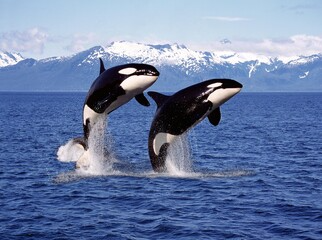
Lifespan
Killer whales have quite the impressive lifespan in the wild.
For females, they can live up to 90 years, and some even surpass the century mark! Males, on the other hand, usually live around 50 to 60 years, although a few manage to reach their 70s.
Interestingly, female killer whales experience menopause, making them one of the rare non-human species to do so. This unique trait allows older females to take on leadership roles and support their pods, often becoming vital matriarchs.
Reproduction and Lifecycle
Killer whales hit sexual maturity at different ages:
Males typically around 15 years old, while females reach it a bit earlier, between 10 to 14 years.
Interestingly, breeding isn’t confined to certain seasons. After a lengthy gestation period of 15 to 18 months, a female gives birth to just one calf.
When they’re born, these calves measure about 8.5 feet (2.6 meters) and weigh between 300 to 400 pounds (136 to 181 kg).
They’ll nurse for up to 2 years, and females usually give birth every 3 to 10 years.
The bond between a mother and her calf is incredibly strong. Mothers are dedicated to guiding, teaching, and protecting their young, and the entire pod pitches in to help raise them.
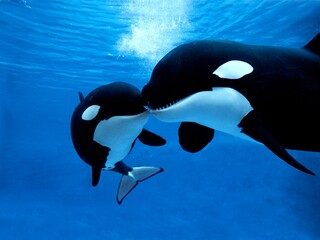
Social Structure
Orcas live in family groups. These groups focus on older females and their descendants. This is called matrilineal structure. Sons and daughters remain with their mothers for life.
This tight-knit social structure allows:
- Transmission of knowledge across generations
- Stable cooperation during hunts
- Shared responsibilities for raising young
Some pods show what scientists call culture. They pass down techniques, like fish herding and wave washing, from one generation to the next.
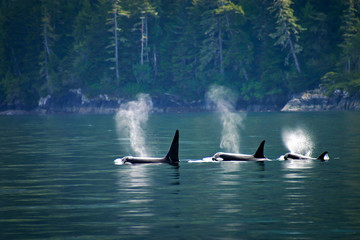
Predators and Threats
Adult killer whales don’t have any natural predators. However, their calves can sometimes fall victim to large sharks or even orcas from different species.
The biggest threats they face today are all due to human activity:
- Pollution: Harmful chemicals like PCBs build up in their fat, which can negatively impact their ability to reproduce.
- Ship noise: This disrupts their echolocation and communication, making it harder for them to navigate and interact.
- Prey depletion: Overfishing of salmon and other essential species is reducing their food supply.
- Captivity: Being held in captivity can be incredibly stressful and detrimental to the health and behavior of orcas.
Adaptations
Killer whales have developed many amazing adaptations to survive and thrive worldwide:
- Streamlined body: Reduces drag for fast swimming
- Large flippers: Aid in precise maneuvering
- Echolocation: Emits clicks to locate prey with stunning accuracy
- Blubber: Insulates against cold temperatures
- Complex brains: Among the most intelligent creatures on Earth
- Social learning: Pass down hunting methods and behaviors through culture
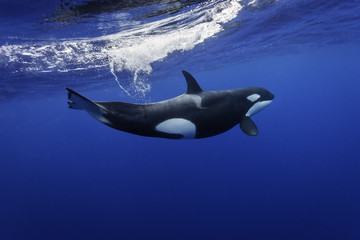
Conservation Status
According to the IUCN Red List, killer whales are currently classified as Data Deficient on a global scale. However, certain populations are facing serious threats and are considered endangered.
- For instance, the Southern Resident killer whales found in the Pacific Northwest are listed as Endangered under the U.S. Endangered Species Act.
- These magnificent creatures are up against several challenges, including pollution, a dwindling food supply, and disturbances caused by boat traffic.
To help protect them, various conservation efforts are underway, such as:
- Establishing marine protected areas
- Implementing salmon restoration programs
- Enforcing restrictions on whale-watching activities
- Promoting anti-pollution legislation
Killer Whales and Humans
In the past, killer whales were often misunderstood and feared, which is how they got their name. Nowadays, though, they evoke a sense of awe, spark scientific interest, and ignite passionate conservation efforts.
While some of these magnificent creatures have been kept in captivity for entertainment purposes, more and more people are starting to appreciate their intelligence and emotional depth. This shift in perspective is fostering new attitudes toward them. Documentaries like “Blackfish” have played a significant role in changing public opinion, leading many to question whether wild animals should really be confined behind glass.
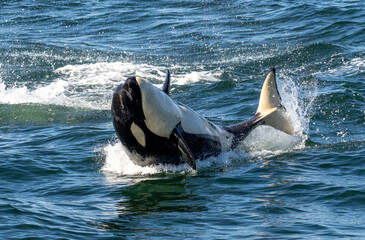
Subspecies and Ecotypes
Killer whales are one species, but they have great behavioral and physical differences. Many scientists think they should be split into several species or subspecies.
Main ecotypes include:
Resident Orcas: Fish-eating, highly vocal, stable pods (e.g., Pacific Northwest)
Transient Orcas (Bigg’s): Marine mammal-eating, quieter, smaller pods
Offshore Orcas: Mysterious, rarely seen, eat sharks and fish
Type A (Antarctic): Hunts minke whales, large and bold
Type B, C, D: Smaller Antarctic forms with different prey preferences
Each ecotype has its own range, diet, dialects, and social norms.
Interesting Facts
- Did you know some fascinating facts about killer whales? For starters, these incredible creatures can actually mimic the sounds of bottlenose dolphins and even human voices!
- Orcas have been known to beach themselves to catch seals, showcasing their remarkable intelligence and willingness to take risks.
- In Argentina, there’s a group that has been passing down the art of seal hunting for over 40 years!
- When it comes to sleep, orcas have a unique approach: they rest with one half of their brain awake, allowing them to come up for air while they snooze.
- Interestingly, no wild orca has ever been recorded as fatally attacking a human.
- And here’s another intriguing tidbit: orcas are one of the few animals, alongside humans and pilot whales, that experience menopause.
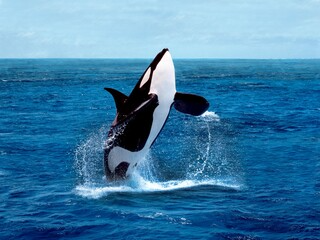
Conclusion
The killer whale, known scientifically as Orcinus orca, is so much more than just a marine mammal. It’s a true ocean master, a symbol of family bonds, and a shining example of nature’s intelligence. Killer whales represent the pinnacle of marine evolution, showcasing remarkable social connections and extraordinary hunting abilities.
Yet, despite their formidable presence, they face vulnerabilities. Our actions, pollution, and choices threaten their survival. By protecting these magnificent creatures, we’re also safeguarding our oceans—and ultimately, ourselves.
The killer whale is a breathtaking marvel of ocean life, reminding us of the incredible complexity and beauty of our world. This creature sparks our imagination and captures the hearts of everyone, whether you’re a wildlife enthusiast or just starting to explore the wonders of nature.

